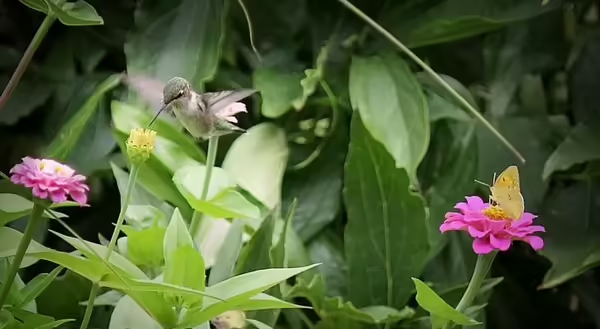
By Jennifer Bass, Extension Master Gardener and Master Naturalist serving Fulton, Mason, Peoria and Tazewell counties
This past weekend I pointed out to my grandkids the first goldfinch of the season I spotted at my feeders. Bird watching is enjoyable for many of us – I had an uncle who had many feeders outside his room in a care facility and he made sure it was filled each day. His nurses often commented they knew little about birds and he taught them a lot. I feed the birds all winter and am excited when I spot a different species. It is fun to also point out to my grandchildren and neighborhood children different birds and their calls. But one bird we especially enjoy seeing throughout the late spring to early fall and that is the hummingbird.
There are 366 different species of hummingbirds but only about fifteen make their summer home in the continental United States. The most only hummingbird found in this area is the Ruby Throated Hummingbird that only breeds east of the Mississippi. This tiny bird (3 ¼ - 3 ½ inches long) spends its winters in Central America and the far tips of Florida. In early to mid-April they begin their 500 mile journey to the north arriving in Central Illinois in late April to early May.
Humming birds nest in deciduous woodlands, adjacent to old fields, forest edges, meadows, orchards, stream borders, and backyards. Tall trees are a favorite perch for hummingbirds because they help provide cover and an escape from predators. One can observe hummingbirds in backyards, school yards, parks, almost any place with shelter and a nearby food source.
They do feed on some insects but as pollinators they look for flowers. If you are thinking of planting a garden to attract hummingbirds know that hummingbirds like red flowers but will visit plants with long tubular flowers. Think diversity when choosing flowers and plant large plots of many varieties. Also consider native plants that have not been hybridized – when a plant is altered its food source may change too. Some natives they enjoy are penstemon (Penstemon digitalis), cardinal flower (Lobelia cardinalis), trumpet honeysuckle (Lonicera sempervirens), salvia (Salvia pratensis), wild bleeding hearts (Dicentra eximia), lupine (Lupinus perennis L.), columbine (Aquilegia canadensis), coral bells (Heuchera richardsonii) to name a few. I also see hummingbirds visit my hostas that have various shades of purple and white. Also, make sure when planting your garden that you are providing continuous blooms throughout the summer. Another thing to remember is to keep your lawn, flowers, and area chemical free because pesticides and insecticides can harm these tiny birds.
In our yards we like to attract hummingbirds with feeders. When choosing a feeder make sure they:
- • are easy and quick to clean;
- • have no hidden parts where mold can grow;
- • have a built-in ant moat if possible;
- • have no yellow parts (yellow attracts bees and wasps).
Even though it may be convenient, do not purchase a commercial red nectar for your feeder. For the nectar solution, be sure to use a ratio of 1:4 cane sugar to water. In hot weather, clean feeders every one to two days and replace nectar solution often. It’s best to set up several feeders rather than one large feeder to support more hummers in your yard because ruby throated hummingbirds may aggressively defend a feeder from other hummingbirds.
South of Smithfield, Illinois Lois White has fed and observed hummingbirds for the past four decades. She has had scientists from throughout the Midwest come to observe, band and learn from her practices. Prairie Moon nurseries has written about her in their catalogue. She welcomes groups and individuals to her small home and has lawn chairs where one can sit and enjoy watching birds flit from feeder to feeder. She may even point out a nest to you, which is about the size of a walnut.
Take time to enjoy the birds that inhabit your yard. Plant a garden, rich in color and provide a source of shelter for them. Who knows, maybe you will be able to point out a colorful species to friends and family.